A systematic theory of DIY electronic culture, drawn from a century of artists who have independently built creative technologies
If there’s one person who has the intellectual generosity, practical know-how and theory background to write a “systematic theory of DIY electronic culture”, it’s Garnet Hertz. Hertz is Canada Research Chair in Design and Media Arts, an Associate Professor of Design at Emily Carr University in Vancouver and an artist whose works put into practice his research on DIY culture, electronic art and critical design.

Garnet Hertz, Phone Safe 2, 2015
![]()
Garnet Hertz, Videodome, 2013
Throughout the years, Hertz has created projects has diverse as a phone hammer with an integrated cable cutter, a fax-based social network, a video game system that you can actually drive in the streets, an analogue virtual reality system and even a Machine for Calling the Department of Homeland Security. Bold and witty, his pieces demonstrate that technology can be opened, defied, played with and personalised. That you can use it to question, protest and expand imaginations.
Hertz is also the author of a number of cult zines that probe into DIY culture, activism, hacker culture, art and critical design. The zines were handmade and not that easy to get hold of. Everyone I know who did manage to get copies would never part with those booklets. However, he recently published with the MIT Press an academic (and hugely entertaining) book titled Art + DIY Electronics.
This publication charts a hundred years of creative DIY technology practices, drawing a history of the maker movement long before it was even given the name of “maker movement”.
As the MIT Press description of the book notes:
Hertz uncovers the defining elements of electronic DIY culture, which often works with limited resources to bring new life to obsolete objects while engaging in a critical dialogue with consumer capitalism. Whether hacking blackboxed technologies or deploying culture jamming techniques to critique commercial labor practices or gender norms, the artists have found creative ways to make personal and political statements through creative technologies. The wide range of innovative works and practices profiled in Art + DIY Electronics form a general framework for DIY culture and help inspire readers to get creative with their own adaptations, fabrications, and reimaginations of everyday technologies.
Garnet Hertz was kind enough to find a moment in his schedule to tell us more about his book:
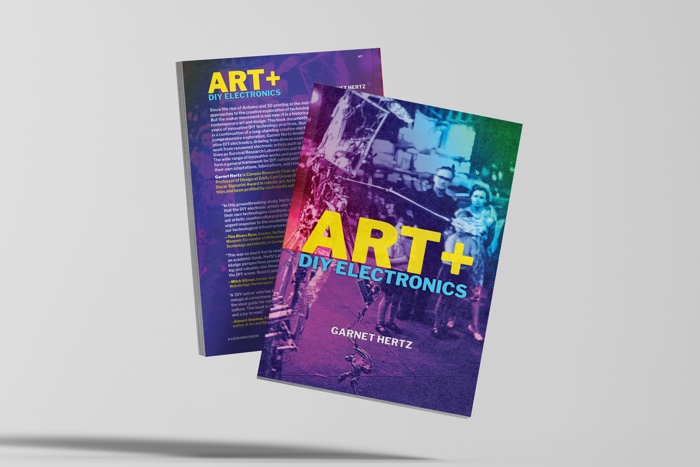
Garnet Hertz, Art + DIY Electronics, MIT Press, 2023

Critical Making was a series of booklets produced in 2012 by Garnet Hertz and consists of ten individual zines
Hi Garnet! I remember reading your Disobedient Electronics booklet as well as your fabulous Critical Making zines. Would you say that Art + DIY Electronics is in line with your previous publications? Same spirit, same kind of energy and content, only not hand-crafted?
Art + DIY Electronics is a bit like a “greatest hits” summary of many projects and people included in Critical Making and Disobedient Electronics. It continues my past research exploring the intersection of contemporary art and experimental technology practices. As a bit of background for readers who are unfamiliar with these projects, they are both handmade zine projects that explore the intersection of the maker movement and hacker culture with contemporary art and critical design.
The most significant departure is that this new project is an academic monograph, so it is considerably more of a scholarly enterprise – it has 40 pages of footnotes, for example. In a plain sense, the book explores my scholarly synthesis through the broader topic of artists using technology. At the same time, my past zine projects have presented more of a curated collection of other people’s project notes and writings. The academic monograph allows for more complex ideas, theories, and research findings to be pulled together – there is more synthesis, citation, and historicization. One aspect I’ve worked on in the book is for it to be as approachable and accessible as a zine – it works to try to communicate complex topics with straightforward and clear language.
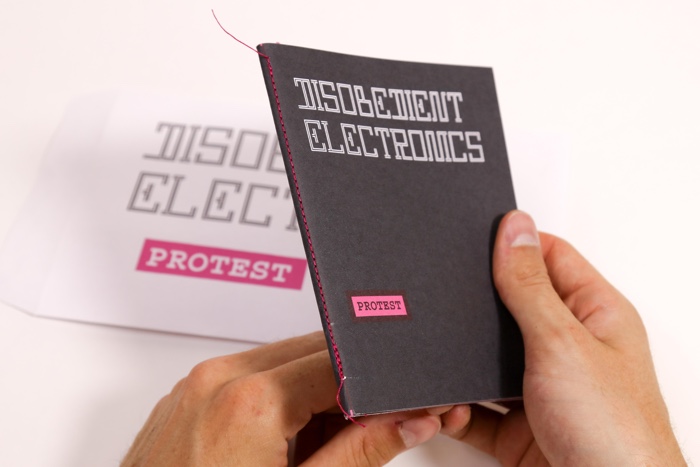
Disobedient Electronics by Garnet Hertz from 2016
The general concept of critical making underpins most of what I’m interested in, and it combines hands-on making, building, and hacking with critical reflection and inquiry. Art + DIY Electronics is generally focused on artists and designers that build in this way. It emphasizes the importance of engaging with technology critically, questioning its assumptions, biases, and broader implications. Critical making is an attitude that individuals can better understand its inner workings, limitations, and potential social and cultural effects by actively creating and tinkering with technology. I encourage individuals, particularly artists, designers, and technologists, to use hands-on making as a mode of inquiry and critique. I aim to bridge the gap between theory and practice and work to foster a deeper understanding of technology and its societal implications by physically creating and modifying it.
Why is it important that artists/makers/citizens tinker, appropriate and modify electronics? Apart from the fun of doing so? What do they bring to society or to our understanding of technology?
To use a term coined by the architects Charles Jencks and Nathan Silver, the world of innovation is filled with “adhocism,” or an improvised collage of available materials. In short, this book is dedicated to artistically-minded hackers who embrace an ad hoc, DIY-style approach. I think this improvisational approach is a vital part of existence: it underlies how most technologies are invented, it is the working method of most artists, and it is at the heart of hackerspaces, maker faires, and research labs globally. Frugal and improvised innovation goes by many terms: jugaad (India), gambiarra (Brazil), zizhu chuangxin (China), junkyard innovation (USA), jua kali (Kenya), and Système D (France). DIY approaches are how much of our world is made – it is almost the antithesis of artificial intelligence and automation, and it is still vitally important in our contemporary world.
In short, an emphasis on DIY is an emphasis on the amateur. This is not to propose that we should do away with professionalism but rather to pay attention to how nonscientists and nonengineers create things outside the standard brackets of science, engineering, and commercial product design. Yes, we still need professional engineers to do stress analysis tests to ensure our buildings and bridges are safe, for example—but we also need to pay attention to technologists on the outer margins of industry. The historical record shows that radically independent technology producers are a flourishing source of raw innovation. Pop and tech culture owes a great deal to its outsider and DIY practitioners since they are regularly its heartbeat of innovation.
Throughout my writing, I am motivated by the belief that artists are innovative technology designers. Artists and other non-experts in technology are clearly inventors. However, most art historians and critics need to catch up on this point. Artists do more than generate ideas—they are also designers and hackers who engineer technologies in novel ways. Outlining historically significant projects helps illustrate how DIY practices have produced raw innovation in technical culture. These artists are often significantly more exciting and innovative than their commercial startup counterparts.
The history of electronic art I have outlined shows how electronic objects can float between communities in art, design, computer science, the humanities, and industry. For this reason, grassroots organizations of electronic artists vigorously carved out their own subcultural terrain in the 1980s and 1990s. A few different influences lay the foundation for my personal perspective of artists as inventors – and this tilts the book’s perspective. The most notable are Billy Klüver and his work with Experiments in Art and Technology in the 1960s, Mark Pauline and Survival Research Laboratories in the ’80s, Krzysztof Wodiczko and his concept of Interrogative Design from the ’90s, and Anthony Dunne and Fiona Raby with critical design in the 2000s. They all considerably break down barriers between artistic thinking and engineering fabrication.
In the end, we will learn several useful lessons: about how artists can help society, how individuals can powerfully enact political or personal change, and how technological innovation emerges from gaps between traditional disciplines.
I’m very curious about the historical approach of the book. The description on the MIT Press page talks about a “systematic theory of DIY electronic culture, drawn from a century of artists who have independently built creative technologies.” A century? Can you give early examples of DIY electronic culture?
Sure!
The early use of machines and electronic devices in contemporary art was propelled by two core ideas: the concept of the ready-made and Dadaism. Marcel Duchamp coined the term ready-made (“Objet Trouvé”) in 1915 “to describe a work of art that consisted of an everyday object, which became a work of art for the simple fact that the artist had selected it.” When the term was introduced into the art world in 1915, it was commonly used in the United States to describe manufactured goods – and it introduced more than urinals and bicycle wheels into art – it ushered in a whole array of materials, including electronic technology. Duchamp’s concept of the ready-made, symbolized by ordinary objects like Bicycle Wheel or Fountain, challenged traditional art norms, asserting that art could be any object an artist deemed it to be. This audacious perspective not only revolutionized 20th-century art but also paved the way for the use of everyday technological materials art, like in his own project titled Rotary Demisphere (Precision Optics) in 1925.
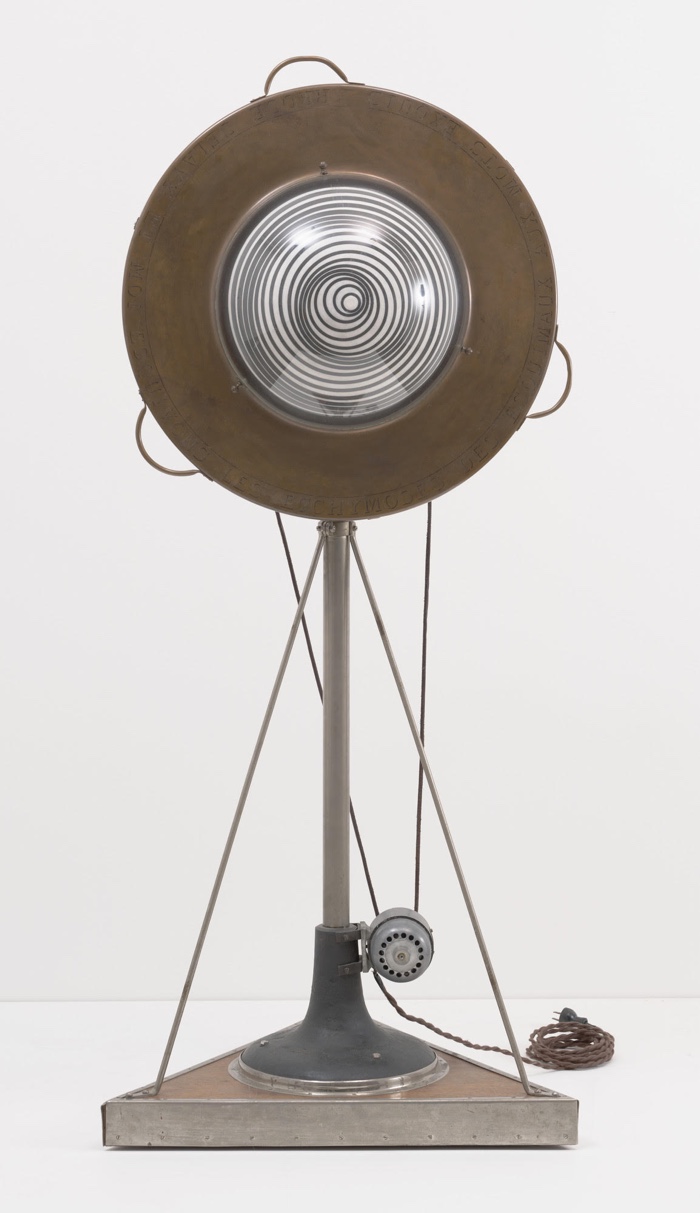
Marcel Duchamp, Rotary Demisphere (Precision Optics), 1925
Rotary Demisphere (Precision Optics) from 1925 is a mechanically-driven kinetic art piece that uses a motor to spin a geometrically painted curved surface. The top features a half-spherical object that spins, and because it is painted with a geometric spiral pattern, its motion creates a pulsating and moving “op art” optical effect. This piece is likely one of the best-known century-old electronic art pieces, but many others exist from that period. Other memorable examples include Naum Gabo’s Kinetic Construction No. 1 (Standing Wave) from 1920 and László Moholy-Nagy’s Light Prop for an Electric Stage (Light-Space Modulator) from 1930.
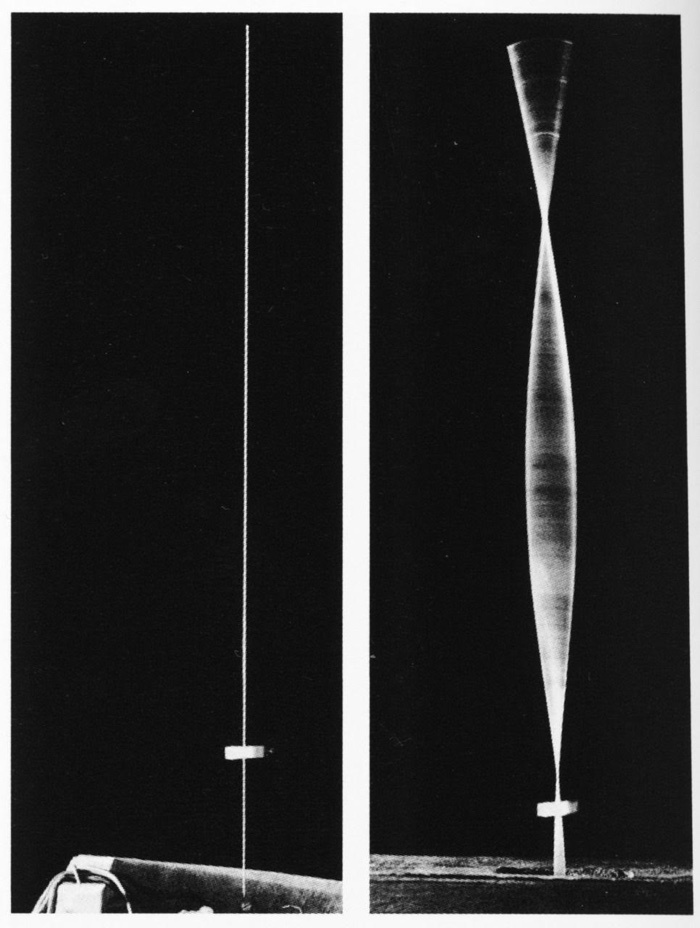
Naum Gabo, Kinetic Construction No. 1 (Standing Wave), 1920
Naum Gabo’s Kinetic Construction No. 1 from 1920 is comprised of a single rod of vertical wire with a balancing weight near its base. The wire is set in motion with a clock spring that produces a slender volumetric shape as it resonates back and forth. Instead of merely evoking motion, like the Cubists or Futurists, this work integrated mechanical movement into art.
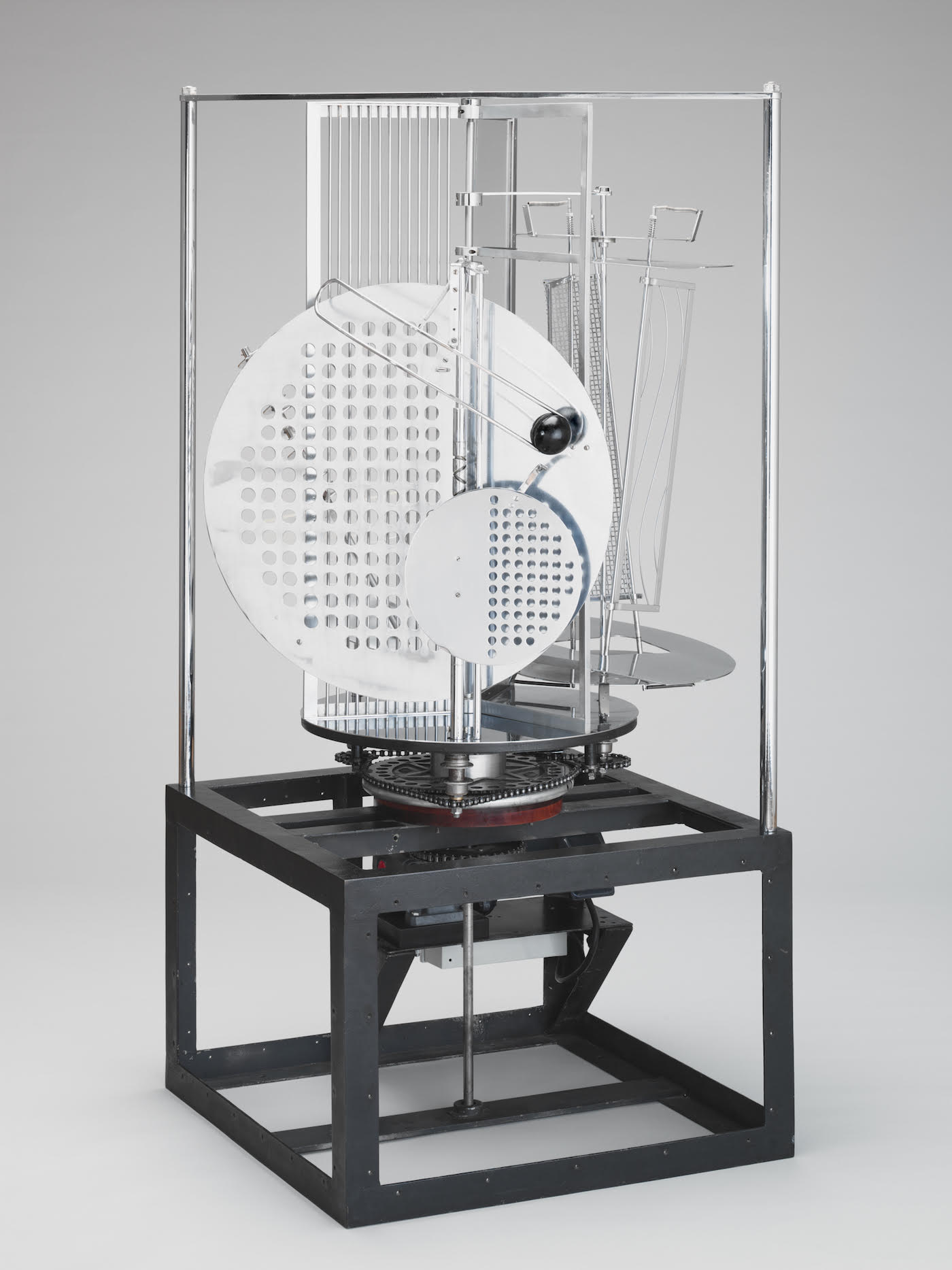
László Moholy-Nagy, Light Prop for an Electric Stage (Light-Space Modulator), 1930
Similarly, László Moholy-Nagy’s Light Prop for an Electric Stage (Light-Space Modulator) from 1930 expands on the concept of kineticism in art. Using an electric motor to rotate several vertically oriented pieces of reflective metal, he produced optic effects when its kinetic surfaces interacted with light.
These two pieces together also show how electricity and mechanics also give some indication as to the evolution of electronic art in the 1920s – at the start of the decade, projects were relatively simple. This had matured by the 1930s into considerably more than a kinetic novelty, with artists building various complex electromechanical projects.
Do you think the industries that develop, manufacture or even advertise electronics and digital devices are paying attention to what adepts of the DIY electronic culture are doing with their products?
For the most part, not at all. This is a crucial motivator in writing this book – industry does not actively track the lifespan of electronic products beyond a half-assed appeal to recycle them. A significant flaw in commercial industry is that it only cares about how products sell, not how they are used or adapted. I’ve spent a chapter of my book focused on this theme, which uses the “zombie” as a metaphor: I see that many, many artists actively use obsolete technological materials in their work, and in many senses, artists give a fascinating “afterlife” to systems after they have headed for the scrap heap of society.
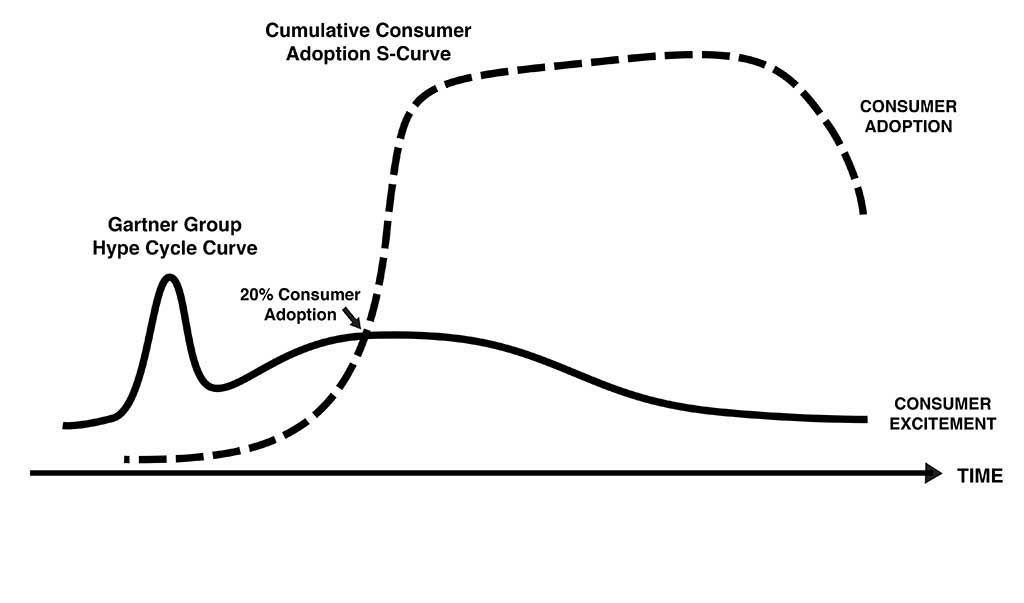
Gartner Group’s Hype Cycle diagram, invented by Jackie Fenn at the Gartner Group in 1995
Part of the mindset problem can be seen in Gartner Group’s Hype Cycle diagram, which was invented by Jackie Fenn in 1995: “The hype cycle was started as a single Gartner research note I published in 1995, making the observation that technologies tend to follow this cycle of over-enthusiasm and disillusionment, prior to a deeper understanding of where they really apply.” In this model—where time runs from left to right and excitement and sales adoption is represented by height—new technologies and products go through a “hype cycle phase” (solid line, left of diagram) that is typified by the excitement over a new technology outstripping its ability to deliver actual benefit to people. This results in an initial rise and crash of excitement as engineering maturity lags consumer expectations. As engineering and product development improves into usable products, individuals purchase technology as a commonplace consumer commodity (dashed line). As consumers adopt the technology, sales continue until the product becomes obsolete, when adoption drops off (right of the diagram).
While incredibly insightful and useful, the diagram lacks any acknowledgment of reuse or repurposing – it is solely focused on graphing social excitement (“hype”) in comparison to product sales. The graph cannot describe what happened to vinyl records in the 2010s, for example, and it cannot similarly graph how folks circuit bend old electronic toys from the ’80s and ’90s into musical instruments.
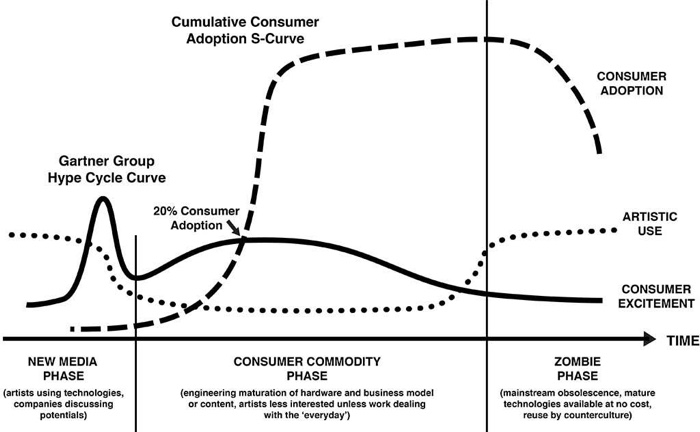
Gartner Group’s Hype Cycle diagram with Hertz’s New Media, Consumer Commodity, and Zombie Phases overlaid to correlate to artistic use and reuse
This lack of acknowledging reuse led me to embrace the metaphor of a zombie with Jussi Parikka in 2012 in a Leonardo article titled Zombie Media: Circuit Bending Media Archaeology into an Art Method. Jussi Parikka and I refer to zombie media as “concerned with media that is not only out of use, but resurrected to new uses, contexts, and adaptations.” This concept is helpful in describing how SRL feeds from the heavy industrial-mechanical terrain of San Francisco that was gradually displaced by the information economy. In Art + DIY Electronics I build off this ‘zombie media’ concept and extend it into the idea of ‘zombie technology.’
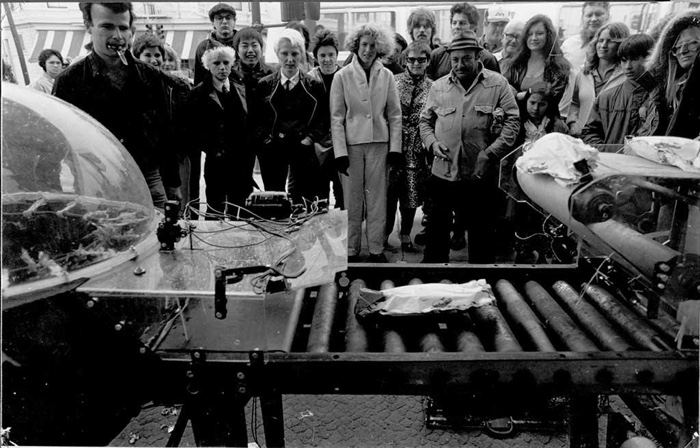
Mark Pauline of Survival Research Laboratories at SRL’s first performance on February 25th, 1979 in San Francisco. The event was titled “Machine Sex,” and it featured a device called “The Demanufacturing Machine” that violently shredded an assortment of devices, flinging the trashed bits toward the audience
I primarily use the work of Survival Research Laboratories (SRL) as an example of this – SRL is a performance art group known for creating intense, chaotic events using specially designed machines, robots, and explosive devices. Repurposed and hacked heavy industrial equipment forms the basis of most of their devices. Founded in 1978 by Mark Pauline, the group’s productions are characterized by a combination of mechanical artworks and live performances, often involving large-scale machines that interact with each other in unpredictable and destructive ways.
I write about SRL because they play a crucial role in the San Francisco tech counterculture, which has given birth to everything from Burning Man to Battlebots. SRL is renowned for its challenge to traditional notions of art and performance. Rather than focusing on human-centered performance or traditional theater, SRL’s shows highlight the unpredictability of machines and the potential dangers of the increasingly technologized world. SRL also throws a monkey wrench into the standard Gartner Hype Cycle diagram.
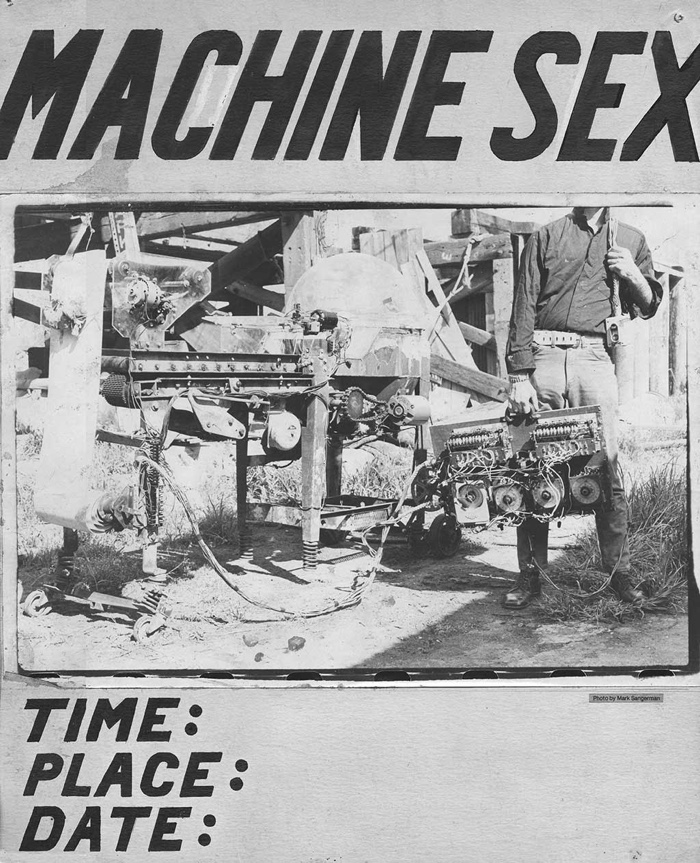
Promotional poster for Survival Research Laboratories’ first performance on February 25th, 1979 in San Francisco. The event was titled “Machine Sex,” and it featured a device called “The Demanufacturing Machine.” Mark Pauline stands in the foreground, holding the control unit of the device. The device was built mainly using scrap industrial equipment
Splitting the Gartner Group Hype Cycle diagram into three distinct phases helps in rethinking these dynamics, with the “new media” phase on the left, the “consumer commodity” phase in the center, and the “zombie media” phase on the right. The new media phase involves exploring the potential creative and business uses of the technology, with artists, inventors, and other researchers continually experimenting with an array of new techniques and devices (left). As engineering maturity and consumer adoption (represented together as a dashed line) grow, interest from artists usually wanes, perhaps as a sign that artists typically step aside from working on developing technology objects when they become formal engineering endeavors (center). Put differently, experimental hardware bricolage is followed by hardware engineering, which then reverts to hardware bricolage after the product is obsolete, cheap, or free. Although artists will use all materials and technologies while building work, they and other DIY practitioners have more advantages to the far left or far right of this diagram, primarily because of the lack of money and organized competition. The far right of the graph is particularly interesting, and it is where the Demanufacturing Machine might sit if plotted: it used a bricolage of mature technologies that were available (or stolen) at no cost.
Seen from afar, DIY electronic culture has a very male, macho aura. Is it an unfair prejudice? How active are women in that DIY electronic field?
You are mainly correct – although I see this primarily as a problem with the historicization of the field, not a lack of female involvement. In other words, women appear to be much more active in the real world of DIY electronic culture than they do in history books on the topic – men often unfairly steal the historical spotlight from female artists doing more innovative work.
As a response to this problem, I’ve worked to try to amplify some of these female voices in the book that I feel deserve to be historicized – like Diana Burgoyne, Nancy Paterson, Natalie Jeremijenko, and Darsha Hewitt – in part because the macho aura of the subculture is still quite prevalent. There is still a ton of work to be done on this front – a hundred books could be written on innovative female artists using technology, and there still would be a lack of historical equity.
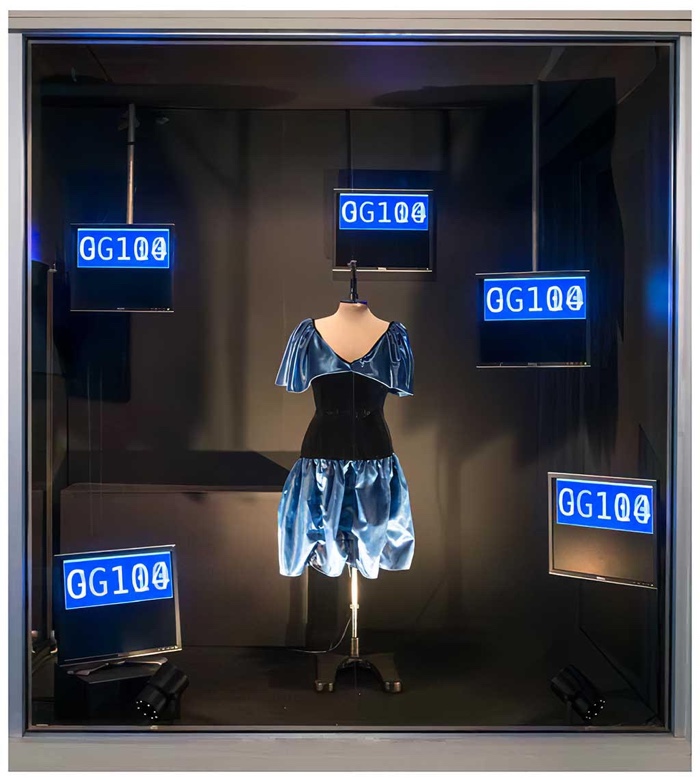
Nancy Paterson’s Stock Market Skirt, 1998. The custom robotic system raises the hemline of a skirt when financial stock prices rise, which was one of the first telerobotic pieces on the internet
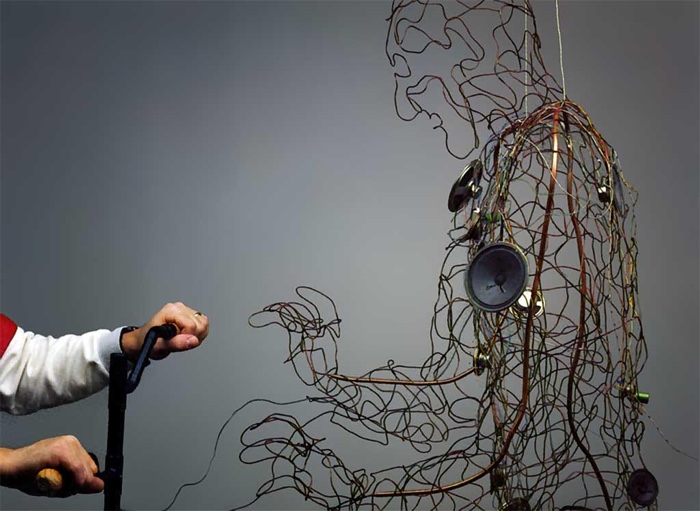
Diana Burgoyne, Wire Figures, 1985. Audience members can grasp the handlebars (left), which trigger audio components in the electronic sculpture (right)
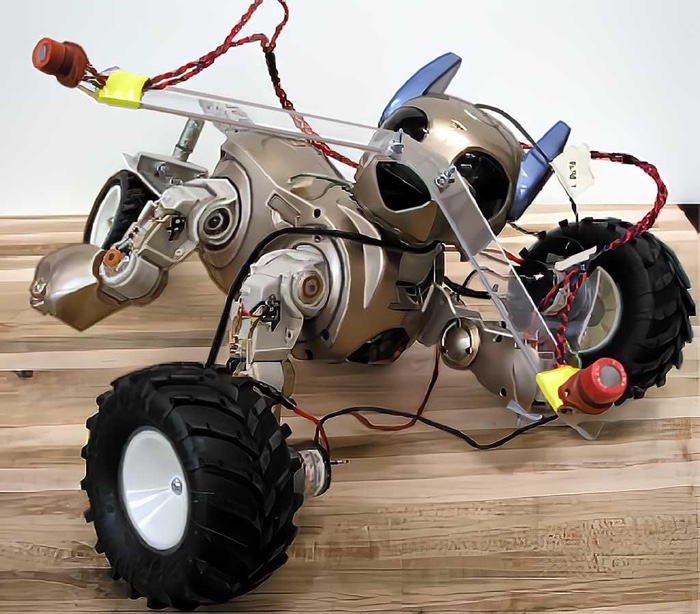
Natalie Jeremijenko, Feral Robotic Dogs, 2003. In this project, robotic toy dogs are modified with rugged wheels and motors to help it travel over outdoor terrain. Volatile organic compound pollution sensors are mounted on a beam connected to the nose of the toy. The devices are built to create a media spectacle to visualize environmental pollution in an engaging and legible way

Darsha Hewitt performing her piece 20 Oscillators in 20 Minutes at the Piksel 2012 Festival in Bergen, Norway. In the project, an audio circuit is assembled live in front of an audience
In other ways, I think the field of electronic and mechanical tinkering has been typecast as a masculine activity – and that this stereotype significantly damages its feminine voice.
One example of a macho aura that partially dissolves after looking at the specifics can be seen in our previous example of Survival Research Laboratories. SRL specializes in mechanical spectacle, similar in some senses to a monster truck show, a tractor pull competition, or a demolition derby. Although there is an aggressive and punk aspect to the work, it would be a shortcoming to view it as only a display of masculine machismo – the historical details are considerably more complex.
SRL was born out of the San Francisco punk scene in the late 1970s. Although the organization was Pauline’s construction, SRL soon started functioning as a team effort, which included over thirty female collaborators in the mix. In its current form, Survival Research Laboratories is massively female – women of SRL have been leaders in machining, welding, Internet telerobotics coding, security, mechanics, electrical, carpentry, and video production of the group.
Survival Research Laboratories holds several engineering firsts to their name, including being the first group to stream live wireless video over the web in Austin in 1997. They were also the first civilians to code and use telerobotics for lethal devices over the web in 1997 (in case that is your kind of thing), they performed the first mechanical test of a robotic swarming/flocking algorithm in 1992, and they were the first to use an animal-controlled robot in a performance. Women were at the core of all of these innovations, and form the heart of SRL. To simply discredit SRL as “boys with toys” is historically lazy and wrong, plus a massive disservice to the women of SRL. Survival Research Labs pushes the envelope of art, performance, and technology, and it does this with formidable feminine energy.
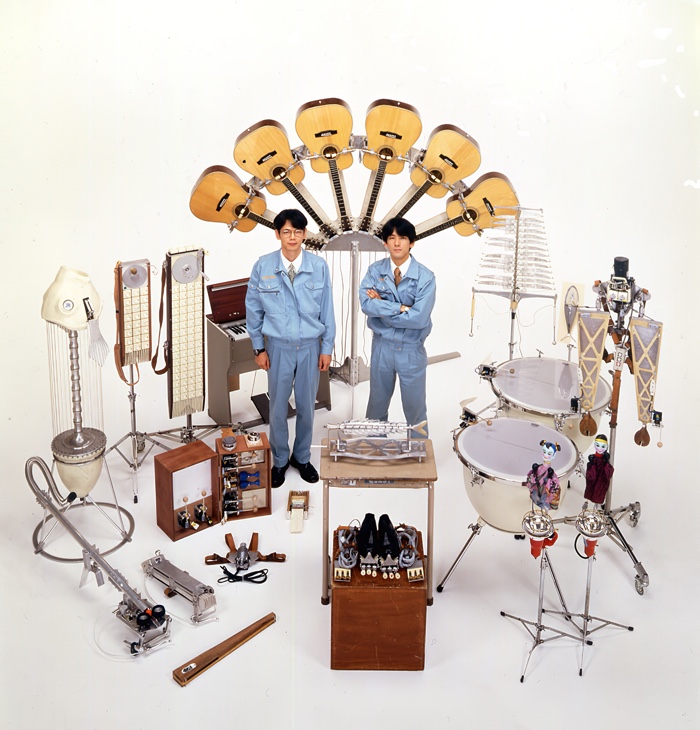
Maywa Denki showing their Tsukuba series of percussive electromechanical devices in a promotional image from 1999. Maywa Denki was founded in 1993 by brothers Nobumichi Tosa (right) and Masamichi Tosa (left)
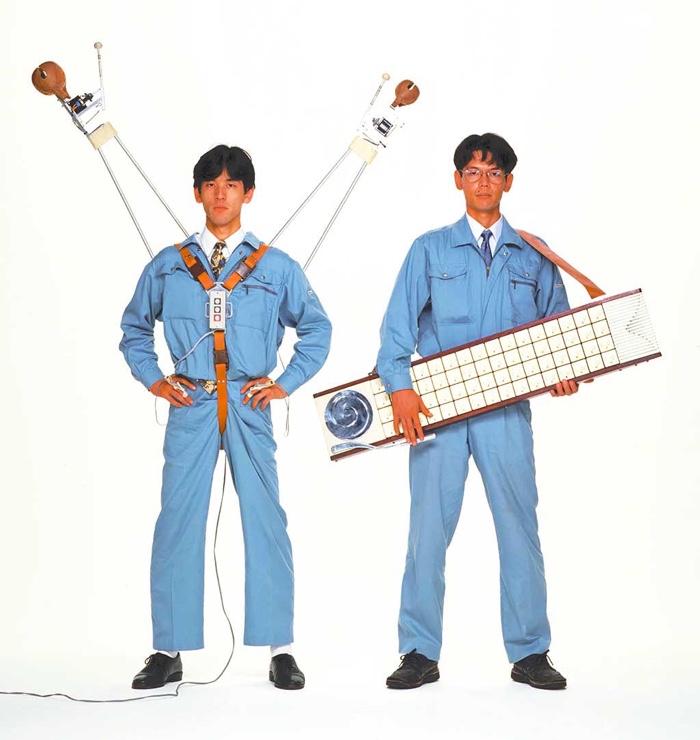
The Tosa brothers form the core of Maywa Denki, with Nobumichi Tosa (left) and Masamichi Tosa (right). Nobumichi Tosa shows the Pachi-Moku, a backpack-type of winged Tsukuba Series musical device operated by snapping one’s fingers. Masamichi Tosa shows the Koi-Beat, a manual rhythm-making machine

Detailed view of Taratter MI-03, a custom-built device built by Maywa Denki. The system is worn on the hands and feet, with finger movements triggering the foot-worn actuators to tap the floor percussively
Your book covers the work of the amazing and legendary Maywa Denki. Are they still active today?
Absolutely!
As a bit of background for folks who don’t know of them, Maywa Denki was founded as an “art unit” collaboration between brothers Masamichi Tosa and Nobumichi Tosa in 1993. The group operates as a two-person “parallel world electronics shop.” It embraces a pseudocorporate identity, donning Japanese blue-collar uniforms reminiscent of the small and medium-sized manufacturing companies that helped launch Japan’s economic growth after World War II. I highlight them in my book because they take “corporate roleplay” to a whole new level – they blur the lines between art, design, commerce, products, and critical design in incredibly productive ways.
Maywa Denki describes their work as building “nonsense machines,” quirky and highly customized electromechanical devices best known for whimsically outputting analog sound. Their first set of devices, released in 1993 under the banner of the Tsukuba Series, are elaborate electromechanical machine-music devices that use motors, solenoids, and percussion instead of speakers to produce audio. There are a total of thirty-five inventions in the series, and they all operate on the basic principle of converting electrical power into physical, percussive movement. They are rendered in highly refined materials, crafted with delicate care, and presented by official-looking individuals wearing powder-blue, shirt-and-tie uniforms. The one-of-a-kind whimsy of the devices is presented in a corporate-engineering deadpan style.
Although the Tosa brothers independently built the work in a relatively noncommercial setting, the work is presented as if it comes from a large corporation, and it borrows from industrial professionalism to pull this off. Several other small-scale producers, including Survival Research Laboratories, the Institute for Applied Autonomy, and the Barbie Liberation Organization, embrace corporate role-play. Maywa Denki takes ideas like Julian Bleecker’s ‘design fiction’ and wraps an entire company around it that builds and sells devices that could easily fit Anthony Dunne and Fiona Raby’s ‘critical design’ classification.
Maywa Denki notably takes this role-play as its core identity—so much so that it is an actual company that embraces its quirky, “parallel universe” persona. Maywa Denki serves as a reminder that a trend in DIY practice is that work straddles amateurism and professionalism in fascinating ways.
Thank you so much for your time!
You’re welcome! As a note to readers, the book is available for free via Open Access – and this free access won’t last forever. It can be downloaded here – grab a copy!
Also – please drop me a note if you’d like me to talk at your institution about this book or the history of electronic art. I’m happy to drop into classes via Zoom, or visit you in person. I also welcome institutions that want to partner in curating exhibitions that explore creative technical DIY cultures.
Thanks!
Previously: Interview with Garnet Hertz, Disobedient Electronics: Protest, Critical Making.


